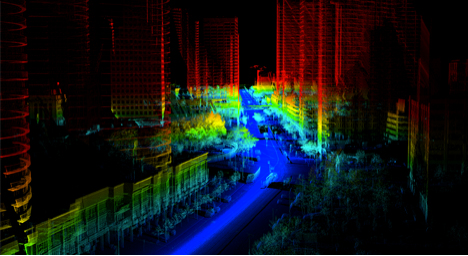With new Lynx Mobile Mapper M1, can you ŌĆśdrive once instead of twiceŌĆÖ?
TORONTOŌĆöWith the launch of the new Lynx Mobile Mapper M1, announced Sept. 28, 2010, Optech has accomplished something thatŌĆÖs long been a goal of president Don Carswell: the ability to collect one million points per second.
ŌĆ£ItŌĆÖs something heŌĆÖs always wanted,ŌĆØ said Wayne Szameitat, international sales manager at Optech. ŌĆ£He takes this pretty personally.ŌĆØ
Using two lidar sensors operating at 500 kHz each, the Lynx M1 represents a 150-percent speed improvement over the companyŌĆÖs previously fastest mobile scanning device, which topped out at 400,000 points per second (200,000 points per sensor). With accuracy better than 10 millimeters, and the aforementioned speed, Szameitat said if you boil the benefits of the new scanner to the simplest terms: ŌĆ£You can drive once instead of twice.ŌĆØ
Szameitat believes that greater collection density will enable faster job completion, and this will drive new business opportunities ŌĆō better documentation of thin power lines, for example, or capturing small roadside sign inventories. Creative service providers and end users will figure out how best to use this new level of detail, says Szameitat.
Gordon Perry, senior project manager at Surveying and Mapping Inc., Austin, Texas (aka SAM Inc.) has some reservations ŌĆö SAM purchased an earlier generation Lynx, a year ago. ŌĆ£IŌĆÖm not sure that we as an end user need to be at a million points per second,ŌĆØ Perry said. ŌĆ£WeŌĆÖre quite happy with 400,000 points per second. And weŌĆÖre producing some really great products for clients with that.ŌĆØ
Even if SAM were in the market for a new Lynx, Perry said heŌĆÖd have concerns with collecting, moving, and storing that much data. ŌĆ£Right now weŌĆÖre out collecting a terabyte a day,ŌĆØ he said. ŌĆ£Now itŌĆÖs going to be two-plus per day. The logistics of moving that kind of data has some pretty significant impact. IŌĆÖm not saying itŌĆÖs a bad thing to get more data, IŌĆÖd just say that we as a company would have to weigh that out ŌĆ” We run a 250-terabyte network right now, and weŌĆÖre already always bumping our head on space.ŌĆØ
One thing the extra points might do, however, is extend the range of the scannerŌĆÖs viability, Perry said. As youŌĆÖre driving down the highway, he said, ŌĆ£the density of data is greatest along that drive line ŌĆ” the data on either side of the vehicle, itŌĆÖs phenomenal. YouŌĆÖre getting 8,000 points per square meter.ŌĆØ But, 50 feet from the truck is maybe 1,500 points per square meter. At 100 feet itŌĆÖs below a thousand. At a couple hundred feet itŌĆÖs in the hundreds.
Thus, ŌĆ£if youŌĆÖre trying to hit a curb, the density of that data might not support you being able to draw that break line.ŌĆØ With a million points to start with, instead of 400,000, ŌĆ£your density is going to pick up,ŌĆØ Perry said. ŌĆ£Is it going to reduce the number of drive lines?ŌĆØ HeŌĆÖs not sure. ŌĆ£It would take a lot of passes and testing before weŌĆÖd be comfortableŌĆØ changing current best practices, he said. Still, the allure of a million points per second is admittedly ŌĆ£cool,ŌĆØ Perry said. ŌĆ£If we were buying a new system today, that might be really important to us.ŌĆØ






